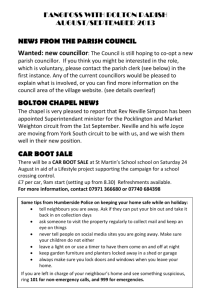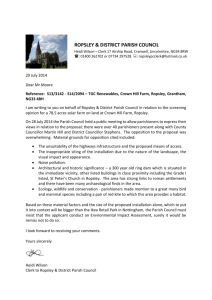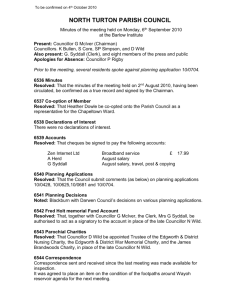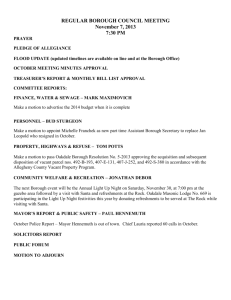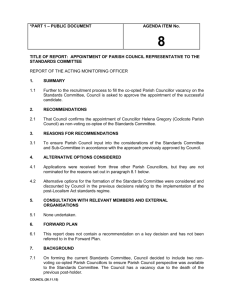apologies - Royal Borough of Windsor and Maidenhead
advertisement
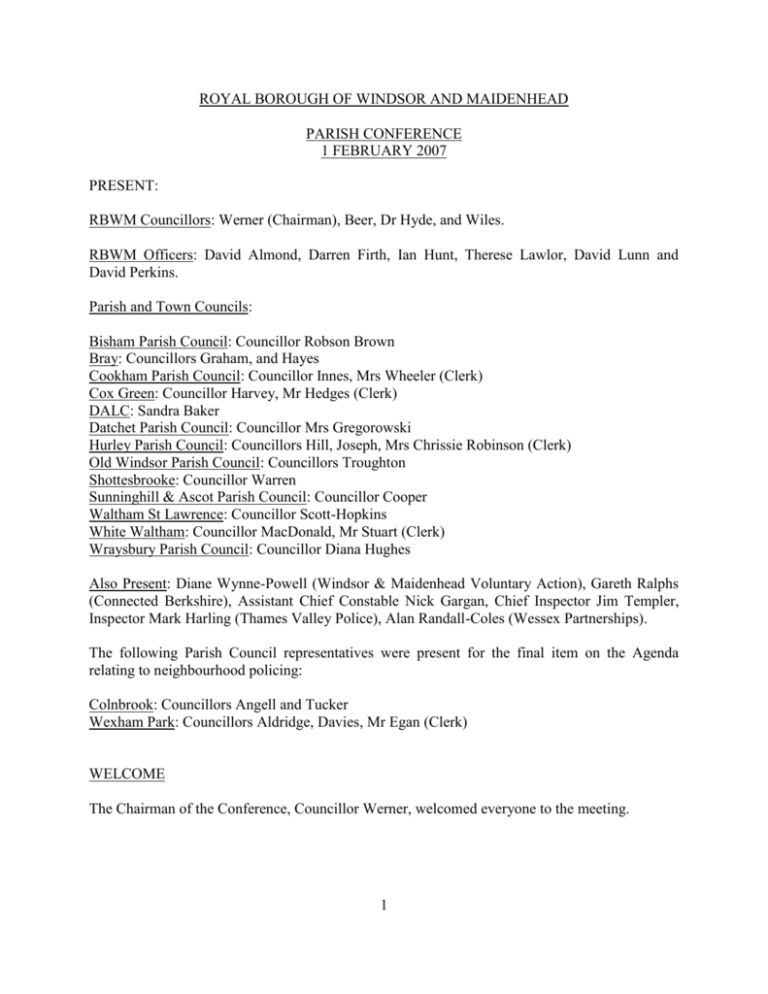
ROYAL BOROUGH OF WINDSOR AND MAIDENHEAD PARISH CONFERENCE 1 FEBRUARY 2007 PRESENT: RBWM Councillors: Werner (Chairman), Beer, Dr Hyde, and Wiles. RBWM Officers: David Almond, Darren Firth, Ian Hunt, Therese Lawlor, David Lunn and David Perkins. Parish and Town Councils: Bisham Parish Council: Councillor Robson Brown Bray: Councillors Graham, and Hayes Cookham Parish Council: Councillor Innes, Mrs Wheeler (Clerk) Cox Green: Councillor Harvey, Mr Hedges (Clerk) DALC: Sandra Baker Datchet Parish Council: Councillor Mrs Gregorowski Hurley Parish Council: Councillors Hill, Joseph, Mrs Chrissie Robinson (Clerk) Old Windsor Parish Council: Councillors Troughton Shottesbrooke: Councillor Warren Sunninghill & Ascot Parish Council: Councillor Cooper Waltham St Lawrence: Councillor Scott-Hopkins White Waltham: Councillor MacDonald, Mr Stuart (Clerk) Wraysbury Parish Council: Councillor Diana Hughes Also Present: Diane Wynne-Powell (Windsor & Maidenhead Voluntary Action), Gareth Ralphs (Connected Berkshire), Assistant Chief Constable Nick Gargan, Chief Inspector Jim Templer, Inspector Mark Harling (Thames Valley Police), Alan Randall-Coles (Wessex Partnerships). The following Parish Council representatives were present for the final item on the Agenda relating to neighbourhood policing: Colnbrook: Councillors Angell and Tucker Wexham Park: Councillors Aldridge, Davies, Mr Egan (Clerk) WELCOME The Chairman of the Conference, Councillor Werner, welcomed everyone to the meeting. 1 APOLOGIES were received from Royal Borough Councillors Grey, Mrs Newbound, and Rayner, and David Penfold (DALC). MINUTES of the last meeting held on 14 September 2006 were approved. ORDER OF BUSINESS It was agreed that the order of business as detailed on the Agenda should be varied. ITEMS COMMUNITY PARTNERSHIPS AND COMMUNITY SERVICES i) Flooding – Development Of Flood Plans For Each Village In Partnership with RBWM/Update on Flooding Actions – The Conference welcomed David Perkins, the Council’s Head of Streetcare, and Darren Firth, the Council’s Emergency Planning Officer, to the meeting, who gave a presentation on Community Flood Planning. (A full copy of the presentation slides are available from the Council’s Democratic Services Team) Mr Perkins outlined a brief summary of the work that been undertaken in formulating a Royal Borough Generic Flood Plan, and also referred to the compilation of the wider Emergency Plan. It was noted that the aim was to engage the local community. He then invited Mr Firth to address the Conference in relation to the Flood Plan document. It was noted that the content of the Plan contained Policy and Background Aims, objectives and Priorities Risk Assessments Roles and Responsibilities Operational Control and Co ordination Communications Warning and Informing/Public Information Resources Recovery Contact Lists The guidance that had been used in formulating and compiling the Plan included 2 Environment Agency (EA) pact and Planning Brochure EA Booklets Other Local Authority Plans Strategic Flood Risk Assessment Thames Valley Community Risk Register RBWM Emergency Plan 1947/2000/2003/1 in 100 year mapping Local Knowledge The Conference was then provided with a summary of the current position within the Royal Borough in relation to the development of flood plans and the following was outlined RBWM Generic Flood Plan (referred to above) Wraysbury and Horton Self Help Group – This had started in 2006, and the Group was about to embark on writing its flood plan. A residents questionnaire had been created requesting volunteers. Datchet Parish Council Plan – This had started in late 2006, and the flood plan was in the process of being compiled. An implementation team had been agreed, together with ‘survivor centres’ including a major resource. In relation to future objectives, it was noted that these included Educate the community at every opportunity Continue working with the EA Complete a plan to adopt as best practice Share template with other riverside communities Use flood plan as a template for community emergency plans (generic) Improve warning and informing methods A list of available references and documents were also outlined for the Conference’s information. The Conference thanked Mr Perkins and Mr Firth for their presentation. Discussion took place, during which it was noted that the Council needed the help and assistance of Parish and Town Councils in dealing with a flood. The importance of using local knowledge was emphasised, and Parish and Town Councils were encouraged to contact Mr Firth to discuss any areas of concern, and /or provide any information and local knowledge. The problems of ‘flash flooding’ was also discussed, together with the difficulties caused by ditches being overgrown and not cleared. It was noted that the vast majority of ditches were privately owned, and Mr Perkins outlined the Land Drainage Enforcement Policy, which the Council had adopted a couple of years ago. The Policy aimed to set out what powers the Council had in this regard, and to seek to clear as many of the ditches as possible. ii) South East England Development Agency (SEEDA) Project – The Conference welcomed Parish Councillor Tony Troughton (Old Windsor PC) to the meeting, who gave a brief 3 presentation on the Parish Council’s involvement in the SEEDA Rural Towns Programme. It played an instrumental role in creating an Old Windsor Community Partnership. It was noted that the aim of the presentation was to inform the Conference of the establishment and development of the Partnership, and also to share this experience to benefit any other parish or town councils who may be seeking to undertake a similar task. Councillor Troughton explained that Old Windsor was a largely dormitory suburb with little industry apart from shops selling the essentials of life. It possessed an older than average population, many of whom relied exclusively on local shops because they lived alone, and did not have their own transport. There was no identifiable village centre, and the main shopping area was run down. Councillor Troughton commented that the more famous residents were reputed to avoid giving directions to their properties, which would take visitors through the shopping area on the grounds that it created the wrong impression. The Conference was informed that the Old Windsor Community Partnership was formed to plan and apply for funds to improve the local environment. The shopping centre was top of the list of priorities. Councillor Troughton outlined to the Members of the Conference the following that the Parish Council had learned throughout the process: Define the boundaries of the area your Partnership will cover. If you do not have a parish council, consider setting one up, allowable under new local government legislation even if you are currently part of a Borough. If you are part of a Parish, get someone on the local/parish council on your side. Know who your friends are Identify a source of intermediate funding. Anything you do will cost money. Hold a public meeting and ask people what their priorities are in terms of local projects. This will use some of your initial funding. Look for people who will help run the fledgling Partnership at the same meeting. Devise a questionnaire and ask people if they are prepared to help. A mandate is then required from the residents for any project, so analyse the feedback from the meeting and decide what your first project will be. Don’t underestimate the talents that exist within your local community. This is particularly true of the retired people who will also have the free time to dedicate to making the Partnership work. When you have established the most pressing need in your locality, find a source of funding. In the Old Windsor case funds were found from the Parish, the Borough Council, the local housing association and an ESF programme called Tick Tock. Study the objectives of the funding provider and make sure your application meets their requirements. Don’t forget that some projects will require running costs, and it is important to identify where these revenue costs will come from. Don’t make mistake of asking for the capital cost of providing a facility and ignore the revenue or running costs. Councillor Troughton also emphasised the importance of writing a constitution for the Partnership. He outlined the following recommendations when embarking on such a task: 4 Make it apolitical Appoint a chairman, secretary, treasurer, and a Partnership Board Limit the number of parish councillors on the Board Ban borough councillors from the Board – political influence and danger of alienating general public and funders. Try to ensure the Board is well balanced, i.e old, young, male/female, and a wide range of experience. Councillor Troughton concluded his presentation by suggesting that the community should be kept informed of what the Partnership is doing. Leaflet drops, and building a good relationship with the local journalists were recommended. The Conference thanked Councillor Troughton for his presentation, and brief discussion took place. In response to a question on what were the qualifications required to obtain such SEEDA funding, Therese Lawlor, the Council’s Partnership Manager, outlined this process, which was set out in the report on Community Planning that had accompanied the Agenda for the Conference meeting. iii) ‘Active Rural Communities (ARC) Project’ – Members welcomed Diane Wynne Powell, from Windsor and Maidenhead Voluntary Action (WMVA) to the meeting, who gave a brief presentation on the work of WMVA and the lottery funded project, ARC. It was noted that WMVA aimed to be the ‘one stop shop’ for the voluntary sector and for volunteering, in support of the community needs of the Royal Borough. It was established in July 1997, to be a Local Volunteering Development Agency for the Borough, and was now part of the national network of LDVA and CVS working to the code of practice set by Volunteering England and the National Association of Councils for Voluntary Service. The core aims of WMVA were outlined as follows: Encourage people in the Royal Borough to volunteer in the local community Provide support, information and training for volunteers Keep accurate records of voluntary opportunities in the Borough and beyond Support voluntary organisations with professional advice and training Form partnerships to develop services to meet existing and identified needs Act as the local information point for all volunteering and community issues. The Conference noted that since 1997, WMVA had helped over 3000 people to get involved in voluntary activities, and there were over 300 voluntary and not-for-profit organisations registered with WMVA. The services provided by WMVA included Volunteer recruitment 5 Telephone helpline Shop window space for week-long displays Promoting local voluntary organisations at events and displays across the Borough Permanent displays of leaflets and handouts Advice on volunteer management Internet access for charitable information Focus on young volunteers Focus on rural community involvement Focus on business community involvement Working with partners for new voluntary services Raising awareness of the voluntary sector in the local media Training opportunities for co-ordinators and volunteers Special rates for client voluntary organisations using photocopiers, laminator, scanner etc. Information on funding sources and application packs Directory of voluntary organisations The ARC project had helped create projects in Cookham, Ascot and Datchet, encouraging local people in these rural areas to co-ordinate volunteering activity. The ARC project had also held 2 annual conferences at Cumberland Lodge in the Great Park in 2005 and 2006. This provided an opportunity for people from rural areas to come together. A further conference (part funded by the ESF project Tick Tock) was planned for Autumn 2007 and all Parish Councils were invited to send representatives. The projects hoped they could be sustained through the Good Neighbour scheme of the Lions Club in the future. The Conference thanked Diane Wynne Powell for an interesting presentation and commented on the good service provided by WMVA. Brief discussion took place on the funding of the service, and the comments of Diane Wynne Powell in this regard were noted. iv) ‘Connected Berkshire’ – The Conference welcomed Gareth Ralphs, the Project Manager, from Connected Berkshire to the meeting, who gave a brief presentation on the work of Connected Berkshire. It was noted that Connected Berkshire was launched to support ICT and stimulate the take-up and use of Broadband applications and services in Berkshire. The Partnership was committed to improving the quality of life for all who lived and worked in Berkshire by creating an awareness of the benefits of technology regardless of product or vendor. The Conference was informed that the project objectives included: Focal point for information, best practice, and case study dissemination and promote greater awareness of ICT Establish a network of wireless hotspots Accelerate the take-up, use and exploitation of ICT. 6 It was noted that Connected Berkshire work drew upon the strength of a number of key players and partners, and these included the Royal Borough, Reading Borough Council, Slough Borough Council, West Berkshire Council, Business Link, BT, SEEDA, Wired Berkshire, CCB, Thames Valley Chamber of Commerce, and See Online. In addition, the Conference noted that the ‘delivery vehicle’ for Connected Berkshire comprised Regional profile/remit from SEEDA Over 200 Berkshire business advised Over 55 broadband connection grants awarded 100% of £450 exploitation grants awarded over 25 ‘hotspots’ added to the Berkshire network The next steps priorities for Connected Berkshire were also outlined, and these included flexible working women into business and wider business support third sector and community focus addressing issues of rural and urban digital inclusion Gareth Ralphs also outlined the operation of ‘hotspotsberkshire’, an initiative which would enable anyone in the county to be within ten minutes of a fast internet connection. Connected Berkshire was working in partnership with BT Openzone to provide new wireless hotspots and enhance the exiting county-wide network. It was noted that wireless hotspots offered a convenient, easy-to-use wireless broadband internet access service, allowing customers to gain wireless internet access at broadband speed. The Conference was also informed of FREE offer worth over £400 Awards to-date had been made in Ascot, Windsor, Boulters Lock, Magnet Leisure Centre Pending Awards at Windsor Leisure Centre, Cox Green Community Centre, Windsor Town Centre. Gaps remained in Hythe End, Old Windsor, Eton, Bray, Shurlock Row, Cookham, White Waltham, Clewer, West Windsor and Woodlands Park The Conference was also provided with details of the BT Community Connections scheme, and noted this offered the opportunity to a community or voluntary organisation to extend its work through the use of the internet. The scheme offered first time applicants multi-media internetready PC and a contribution towards a year’s broadband internet access through BT Total Broadband. Additional information was available from www.btcommunityconnections.com. Mr Ralphs concluded his presentation by distributing some leaflets about the items he had spoken of (available from the Council’s Democratic Services Team). The Conference thanked Mr Ralphs for his informative presentation. 7 v) Community Wardens – The meeting welcomed Mr David Almond, Senior Community Warden of the Royal Borough, to the meeting, who gave a presentation on the work of the Community Wardens. The Conference noted that the aim of the scheme was to tackle anti-social behaviour and improve the local community. The Community Warden was a member of a highly visible patrol to help reduce vandalism, graffiti and anti-social behaviour, and to make it a cleaner, safer place to live. Mr Almond commented that the work of the Wardens was all about building relationships with the community, and that the Wardens in the Royal Borough had become known as the ‘purple people’ because of the colour of their uniforms, etc. Mr Almond also outlined the varying community groups that the Wardens had come into contact with, and these included Day Centres, ‘coffee mornings’, playgroups, youth clubs, and schools. The importance of developing such community links with schools, community groups and businesses in the locality was emphasised. The Conference noted that other than lawful powers conferred on all citizens to take appropriate actions when they witnessed a serious offence being committed, the Wardens had no powers to stop, search, arrest, or detain anyone or to disperse groups or assemblies. They could, however, respond to certain situations by contacting the relevant emergency service etc, if they believed that this had not already been done, and to do so would benefit the community. The Conference thanked Mr Almond for his very interesting presentation, and commented on the excellent work undertaken by the Wardens throughout the Royal Borough. vi) Community Planning In The Royal Borough – This item was not discussed due to the need to move on the last item on the Agenda. However, the Conference had been provided with a copy of the report that had been presented to the Royal Borough’s Cabinet meeting on 25 January on this issue, and Members of the Conference were encouraged to liaise with Therese Lawlor, the Council’s Partnerships Manager, outside of the meeting, if they had any questions or queries on this matter. CRIME AND DISORDER Neighbourhood Policing – The Conference welcomed Assistant Chief Constable (ACC) Nick Gargan to the meeting who addressed the Conference in relation to the roll-out of neighbourhood policing, together with the recruitment and function of Police Community Support Officers (PCSOs). At the commencement of the presentation, ACC Gargan reported that unfortunately his colleague, Chief Inspector Jon Smith, was unable to attend the meeting, and it had been his intention to bring some handouts on the impact of the PCSOs, and third party funding for PCSOs. Copies had been provided to the Democratic Services Team at the Royal Borough, and Parish and Town Council representatives are invited to contact Democratic Services accordingly if they wish to receive a copy. 8 ACC Gargan commented that neighbourhood policing was about community safety, anti-social behaviour, and criminality, and most importantly, working with the community, responding to their needs and aspirations. He emphasised the importance of taking action to respond to the community, and also promising answers back to the community. It was noted that, currently, 130 neighbourhoods out of a maximum of 265 had been rolled-out. In October, a decision had been taken to slow down the roll-out process, to ensure that the implementation of neighbourhood policing was sustainable, ensuing that the 130 or so that had been implemented were robust and working. ACC Gargan also outlined in brief the resourcing of the initiative, and reported on the introduction of neighbourhood specialist officers, which would give the Police a much more noticeable presence in the community. The deployment of the PCSO’s were also outlined, and it was noted that there were now to be a maximum of 530 PCSO’s for the Thames Valley Region. ACC Gargan stated that the priorities for the year ahead included maintaining the existing momentum in recruitment PCSO’s, maintaining the incremental roll-out of the neighbourhoods, and developing better links with the business community. He concluded by saying that where neighbourhood policing had been implemented, it was working, and he fully believed in the concept of the initiative. Discussion took place, during which there were questions about the anticipated timetable for the roll-out of neighbourhood policing across the Royal Borough. ACC Gargan reported that he would ensure that a proposed timetable was available to circulate with the Minutes of the meeting. The Conference also asked questions about the funding for securing additional PCSO’s in their areas, and ACC Gargan outlined how this would operate. Members of the Conference were referred to the handout on ‘Third Party Funding For PCSO’s’ for additional information. Several members of the Conference also outlined their experiences within their own areas of policing and anti-social behaviour issues, and several Members outlined the problems in relation to crime not being reported to the Police. The Chairman placed on record his thanks to ACC Gargan for attending the meeting, and for his presentation and answering questions from the floor. DATES OF FUTURE CONFERENCES Thursday 14 June Thursday 10 October Thursday 31 January 2008 (all to commence at 7.00pm – venues to be confirmed) MEETING The meeting, which began at 7.00pm, ended at 9.50pm 9
